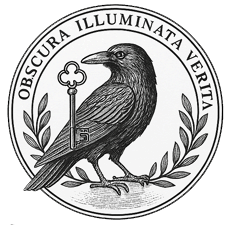The Boy Who Hears Stone
Full Name: Thomas Elwick
Position: Grounds Assistant, StormCroft House
Born: 10 December 1871, Tavistock, Devon
Entered Service: April 1887 (age 16)
Disappeared: 1890 (Age 19)
Status: Unresolved – Final payroll note: “Left. Or perhaps returned.”
Origins and Early Life
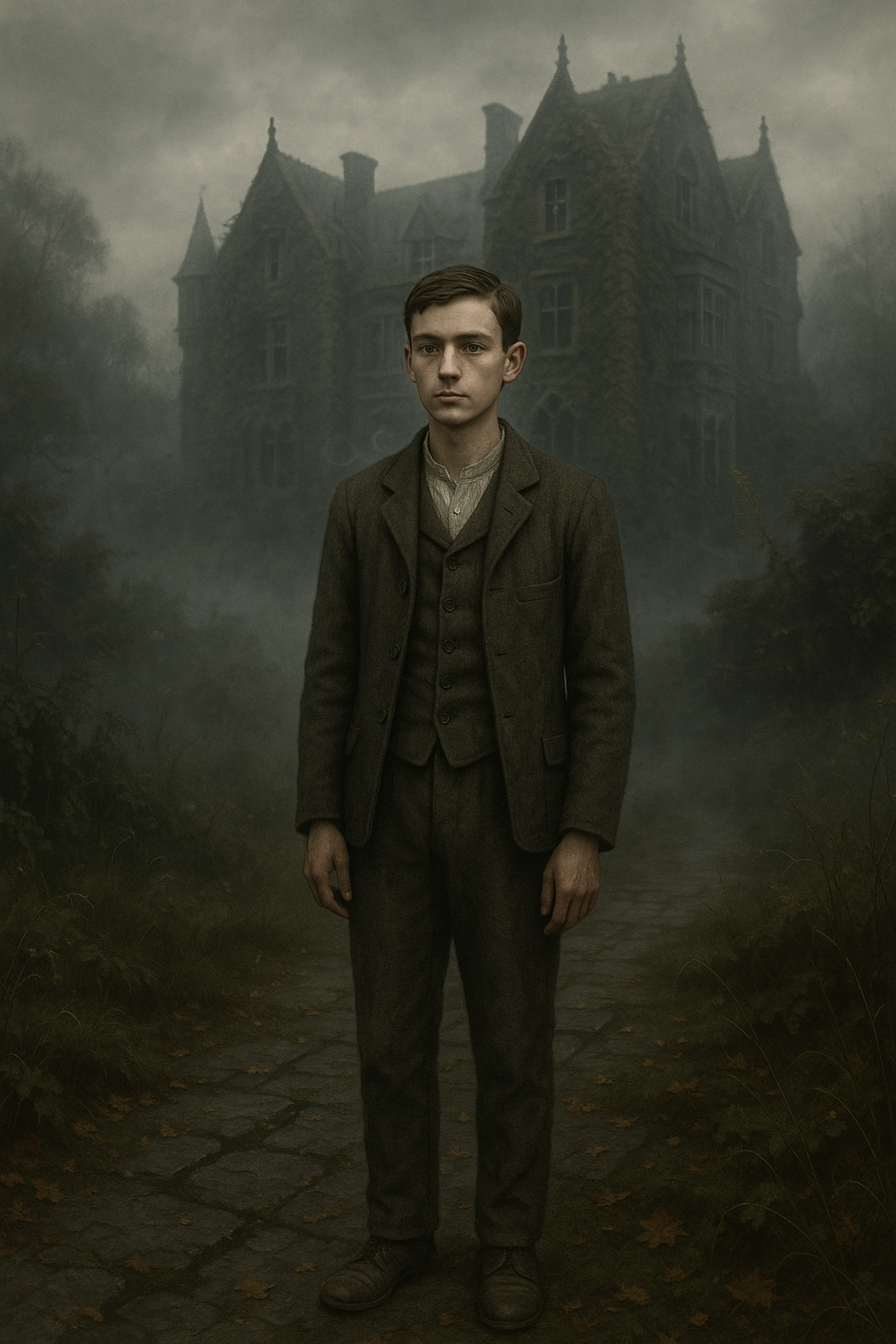
Thomas Elwick was born to a family of quarrymen and cartwrights in Tavistock, a town built into the dark, weathered skin of Dartmoor. From a young age, he displayed what local elders called “a land-listener’s gift” — an uncanny ability to walk in perfect alignment with underground features, even when blindfolded. As a child, he was prone to long silences and strange songs hummed at standing stones. His grandmother, a known dowser, claimed he once located a buried family heirloom by “listening to the floor’s whisper.”
He was recruited to StormCroft House after being seen pacing the border stones alone during fog, drawing symbols in the dirt with a finger, repeating the phrase: “They’ve moved again, but the stones still know where they were.
(image: A rare, atmospheric image believed to depict Thomas Elwick, the enigmatic Grounds Assistant of StormCroft House, standing on a moss-strewn path before the ivy-draped façade of the estate. Shrouded in fog and silence, the scene captures the quiet intensity for which Elwick was known — a still figure in tune with the unseen movements of the soil, stone, and memory. Behind him, StormCroft looms like a half-remembered dream, as if watching him as much as he watches it).
Service at StormCroft (1887–1890)
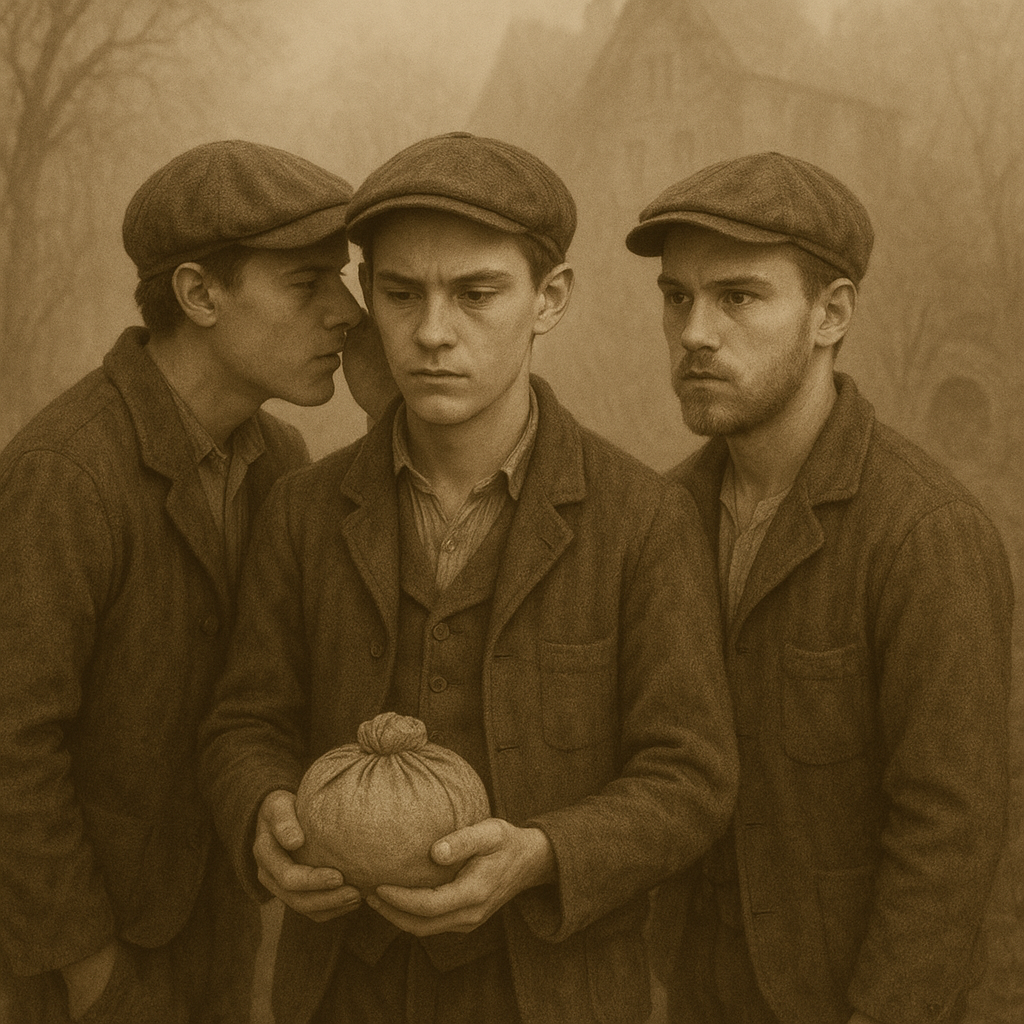
Elwick was assigned to grounds maintenance but rarely performed traditional duties. Instead, he was frequently observed accompanying the Morris Brothers, twin assistants responsible for cellar access and perimeter clearing. The three formed an inseparable unit. When not working, they could be found kneeling in the grass with eyes closed, or sketching symmetrical paths in soot with birch branches.
The staff called them “the Silent Three.”
(image: A sepia-toned photograph, believed to be taken in the winter of 1889, shows three teenage boys in workwear, standing in quiet formation near the mist-shrouded grounds of StormCroft House. At the centre, Thomas Elwick holds a cloth-wrapped bundle with cautious reverence, his gaze lowered and unreadable. One of the Morris Brothers leans in to whisper urgently, his lips nearly touching Elwick’s ear. The other brother stands alert and unspeaking, eyes fixed beyond the frame as though expecting interruption. The background reveals only the blurred silhouette of the manor and the faint outline of the greenhouse path. Their youth, their silence, and the absence of documentation surrounding this gathering give the image a haunting resonance — a visual fragment of something never meant to be seen, yet impossible to forget.
Note: A pencil mark on the back of the original print reads simply:
“He heard what he shouldn’t. And still, he kept it.”)
Daily Rituals and Unusual Behaviour
-
Elwick never used tools unless they had first been “sung to.”
-
He refused to wear shoes in the southern orchard, citing “stone mishearing.”
-
He communicated with the Morris Brothers using knuckle taps and coded whistles.
-
He marked soil vents with charcoal patterns which changed shape seasonally.
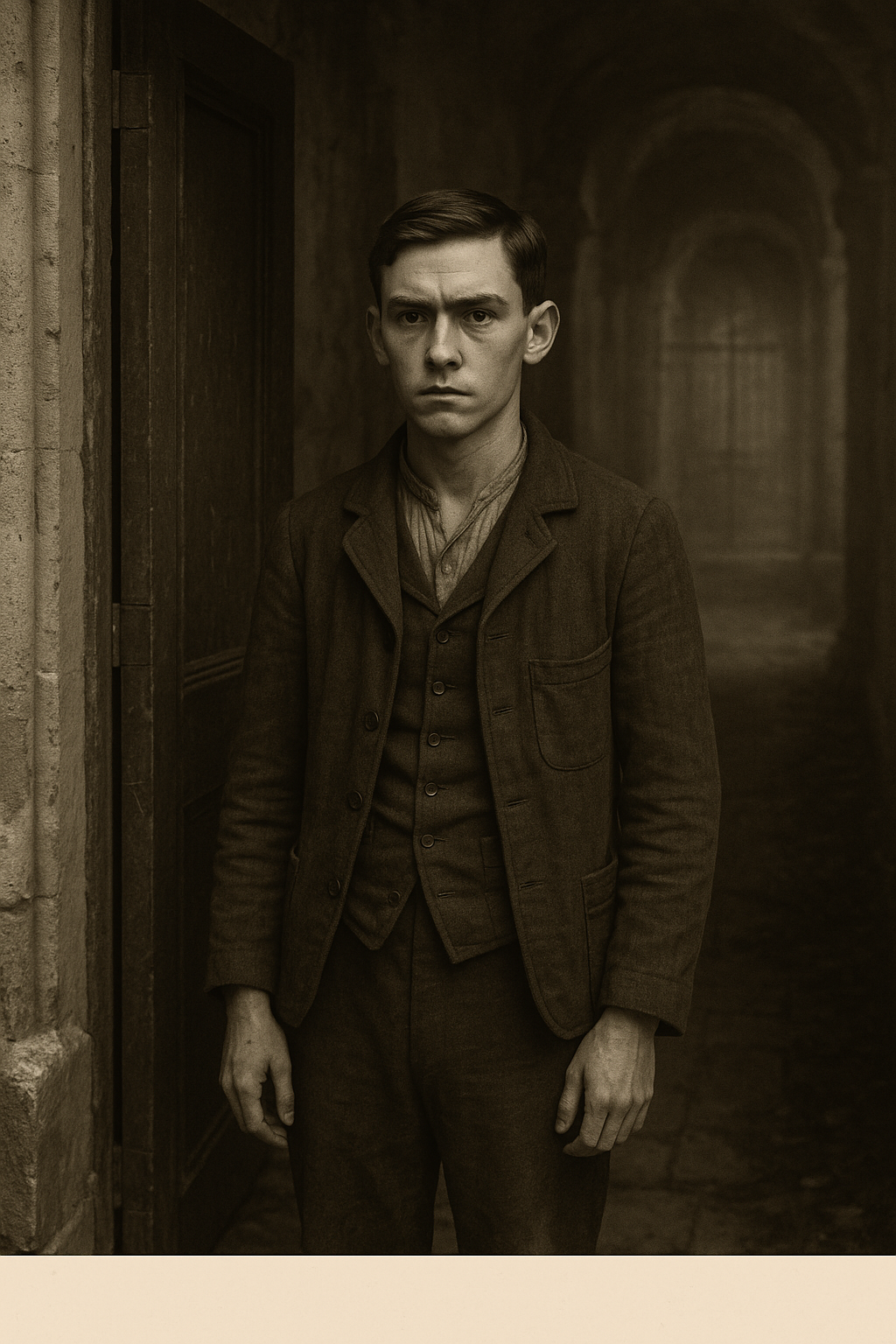
This sepia-toned photograph, quietly recovered from a misfiled security ledger, captures Thomas Elwick standing within a restricted corridor of StormCroft House, believed to be near one of the sealed access points to the underground Fog Spur Line. His expression is unreadable — not startled, but aware. The door behind him stands ajar, revealing a darkened passage thought to have been closed since 1874.
He often wandered unsupervised through sealed areas, particularly those believed to be linked to the underground Fog Spur Line. His memory for terrain was so precise, he once led a team through a mist-locked ravine using only smell and sound.
Dr. Finch noted: “He walks like a question being answered underground.”
Relationship with the Morris Brothers
The Morris Brothers, themselves unsettling in their synchronous speech and pale demeanour, treated Thomas with ritualistic reverence. They would not begin their duties until he circled them three times. On multiple occasions, he was observed binding their wrists with twine before evening fogfall, muttering “hold the path until it’s walked again.”
(image: Elwick was often observed wandering unsupervised through forbidden sectors, yet never formally reprimanded — likely due to the trust placed in his uncanny spatial memory. On at least one occasion, he reportedly led a recovery team through a fog-locked ravine by smell and sound alone.
This photograph is considered the only surviving image of him within the inner eastern corridor, where maps cease and speculation begins. The misted arches and worn stone framing his figure hint at routes not meant to be charted — and a boy who walked them anyway).
Some staff believed the three were conducting unsanctioned experiments involving acoustic resonance and echo patterning beneath the southwest corner of the house. A loose paper, found later in the Morris tool chest, read:
“He hears what we cannot. We move where he hums.”
Final Days and Disappearance
In early 1890, Elwick became increasingly withdrawn. He claimed the stones had become “muffled” and began sleeping beneath the staircase rather than in quarters. On the night of March 11th, he entered the east vent crawl unaccompanied. He did not return.
The Morris Brothers reported him missing 26 hours later, though one was found with soil under his tongue and a broken toe said to have occurred “from standing too long in the hum.”
Elwick’s cap was later discovered hanging from the inner rung of Soil Vent E-3, beneath which the three-note hum (E, E, C) was first recorded. Attempts to seal the vent failed — each plug placed was removed by morning. Echoes continue.
His payroll slip was signed off three days later with the handwritten note:
“Left. Or perhaps returned.”
Legacy and Mythos
-
Referenced in Finch’s notes as “The Boy Who Hears Stone”
-
Soil charts from 1901 still bear his boot patterns
-
Mentioned by name in Edwin Merle’s whispered sleep records
-
The Morris Brothers never spoke again after his disappearance
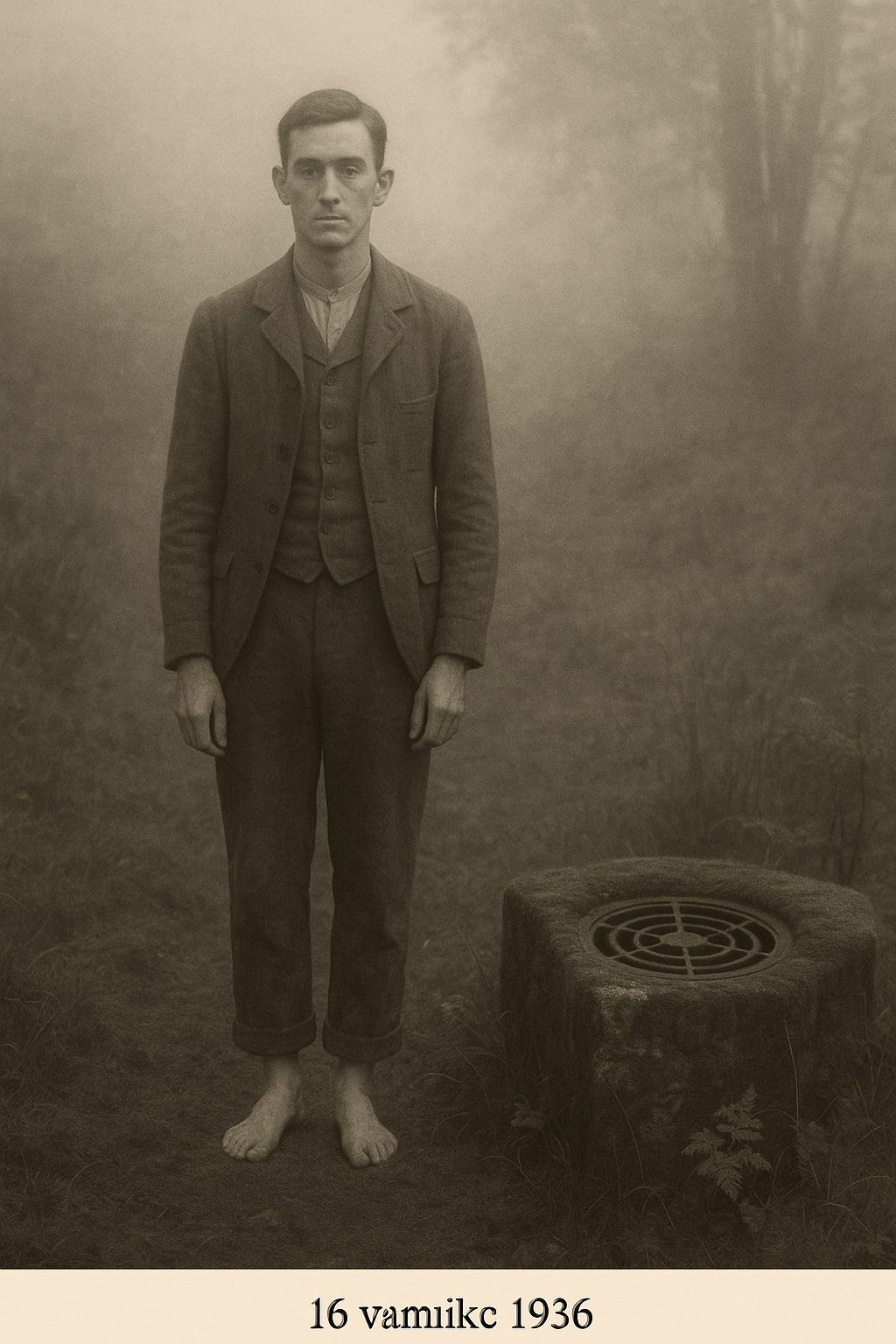
In 1936, a photograph of the grounds showed a faint figure standing barefoot near Vent E-3. When enhanced, the outline bore remarkable similarity to Thomas’s 1888 uniform. No prints were found.
(image: This blurred black-and-white photograph, dated 16 Vamikc 1936, was taken during a routine survey of the overgrown StormCroft estate grounds. Upon enhancement, surveyors noted the presence of a barefoot figure standing beside Vent E-3, a moss-covered outflow long sealed by order of the Finch Committee. The figure bears a startling resemblance to Thomas Elwick, presumed vanished in 1890. His clothing matches the 1888 grounds uniform, down to the fabric weave and collar detail. His posture is unnervingly calm. No staff or residents were unaccounted for at the time of the photo, and no footprints — human or otherwise — were found near the vent.
The back of the photograph was annotated, in faded graphite, with a single line:
“We sealed it. But he did not leave.” The event remains officially unacknowledged in StormCroft records. Vent E-3 was permanently encased in reinforced stone the following year).
In the years since, staff have reported dreams of someone walking just below their feet, matching the pace of their steps exactly — always humming, always in time.
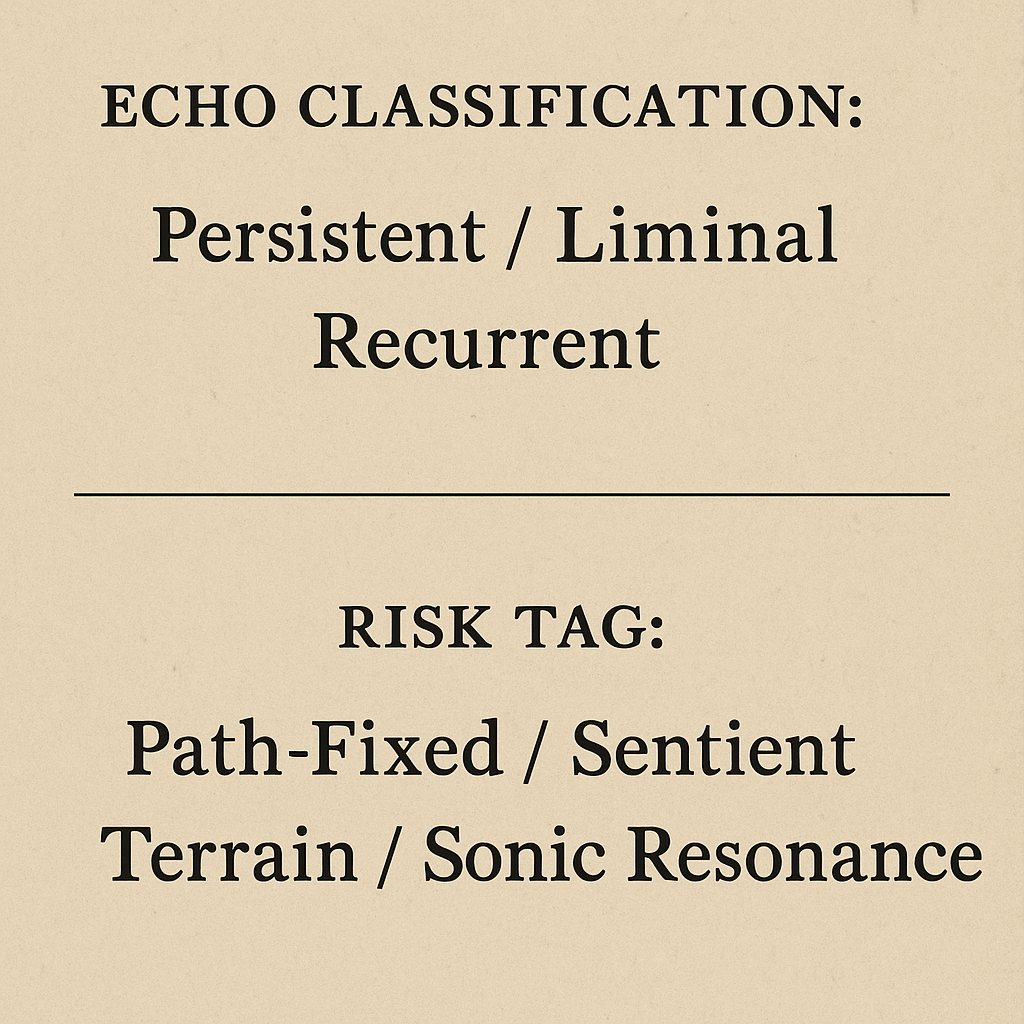
This weathered and partially scorched Echo Classification Card was found misfiled within a locked drawer of Box 12-D, buried in the storm-damaged remnants of the Echo Risk Register archive.
Echo Classification: Persistent / Liminal / Recurrent
Risk Tag: Path-Fixed / Sentient Terrain / Sonic Resonance
(image: Believed to date from between 1931 and 1939, it corresponds to Vent E-3, an outflow site sealed under Finch Protocols following multiple unresolvable anomalies tied to terrain resonance and repeated visual incursions.The Echo Classification is marked as: Persistent – The phenomenon shows no sign of diminishing over time and does not require an immediate trigger to appear.
Liminal – Bound to threshold zones; activity intensifies in areas considered architecturally transitional or unstable.
Recurrent – The pattern or figure repeats in consistent loops, particularly in relation to the lunar cycle and barometric shifts.
Below, under Risk Tag, the following warnings are inscribed in bold archival ink:
Path-Fixed – Subject adheres to a specific vector of movement. Attempts to obstruct or divert it result in atmospheric distortion or terrain shift.
Sentient Terrain – The land appears to respond to presence. Ground pressure, temperature, and flora orientation have all recorded subtle alignment behaviours.
Sonic Resonance – A repeating three-note hum (E – E – C) is detected in soil vents and corridor shafts. Audio samples remain inconclusive, though early speculation linked the sequence to Thomas Elwick’s presence.
Most classification cards were standard issue for incident cataloguing, but this one stands out for its unique pairing of terrain intelligence with sonic markers, indicating an unusually high-risk convergence. It is unknown why the card was never filed formally, nor why its reverse side bears a graphite inscription:
“Not always visible. Always present.)”
It remains a rare surviving insight into the intersection of memory, geography, and recurrence that defined the most dangerous zones of StormCroft House.
